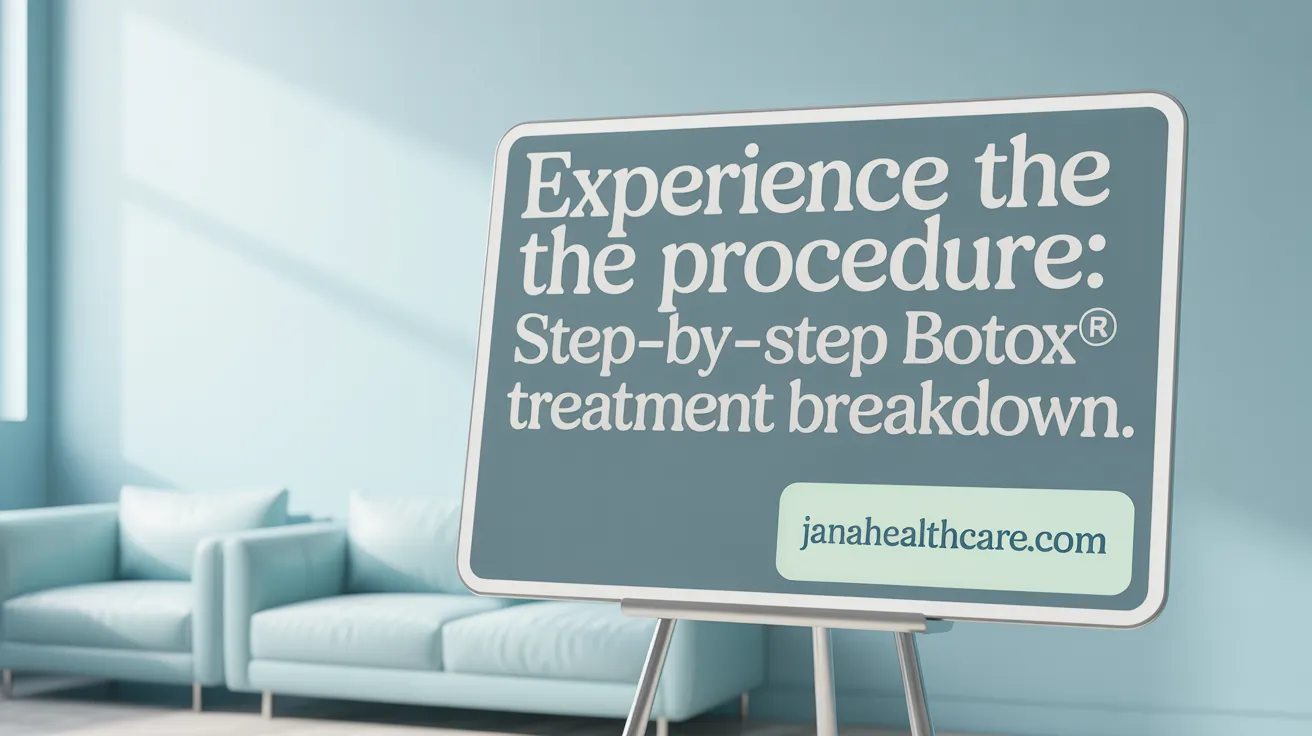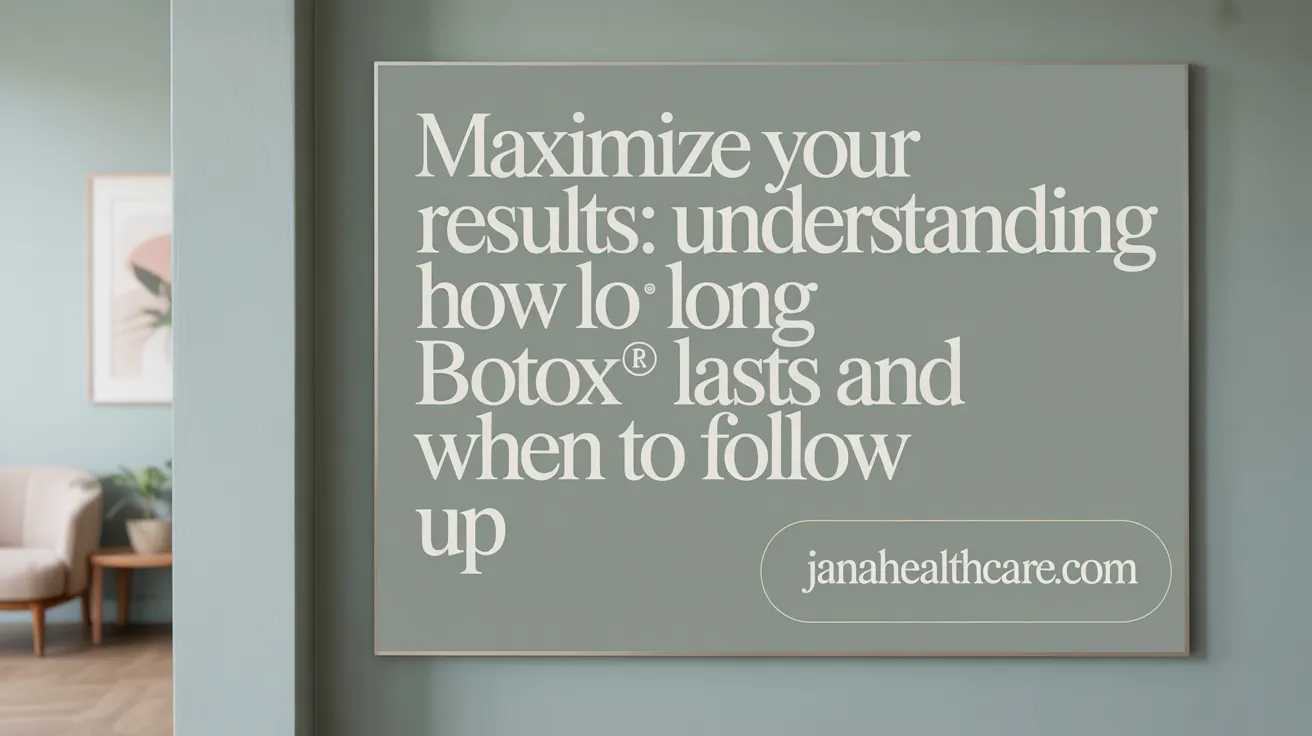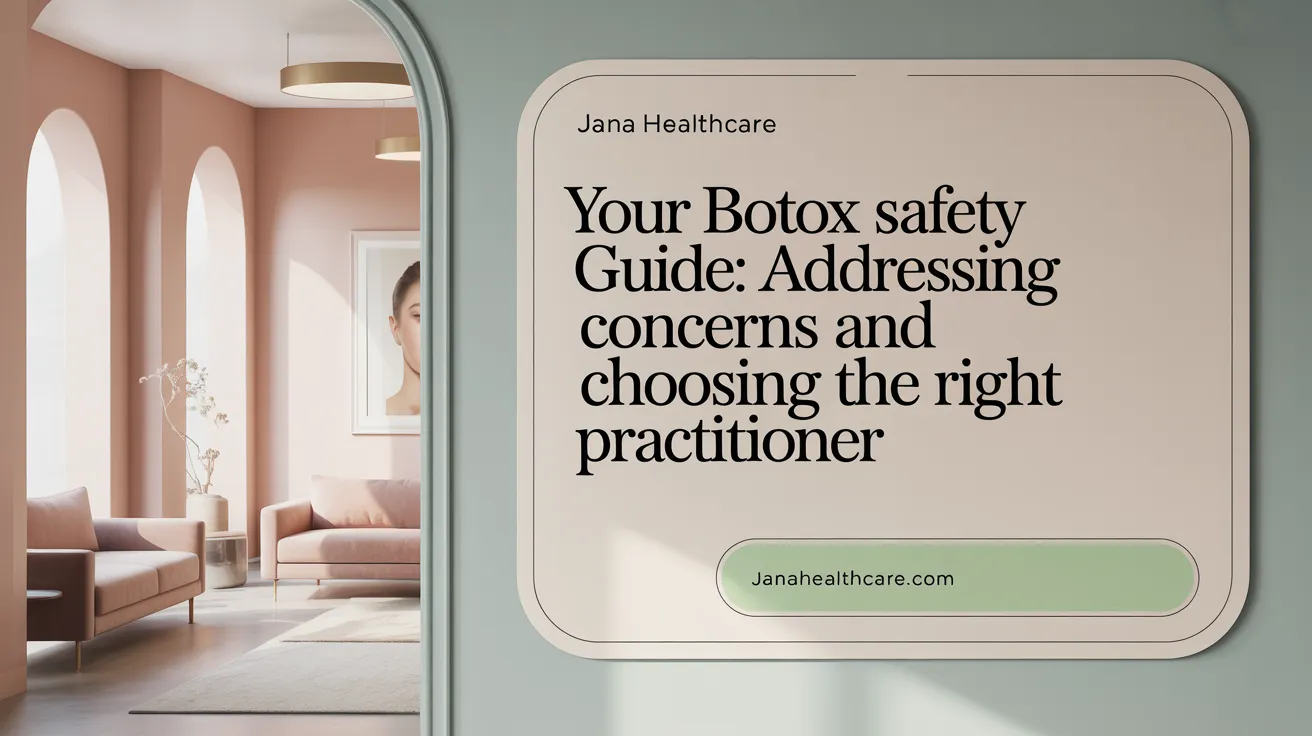Introduction to Botox® for First-Timers
What is Botox® and how it works
Botox® is a brand name for botulinum toxin type A, a purified neurotoxin used to temporarily relax muscles beneath the skin. It works by blocking nerve signals that cause muscle contractions, which helps smooth out dynamic facial wrinkles caused by expressions like frowning or squinting.
Common uses of Botox®
Primarily used for cosmetic purposes, Botox® effectively treats wrinkles such as forehead lines, crow's feet (around the eyes), and glabellar lines (between the eyebrows). Additionally, Botox® has medical applications including treatment of chronic migraines, excessive sweating (hyperhidrosis), and muscle spasms.
Safety and FDA approval status
Botox® is FDA-approved for both cosmetic and certain medical uses, reflecting over two decades of safe clinical application. Side effects are generally mild and temporary when administered by qualified professionals, ensuring a reliable and trusted treatment option for those seeking wrinkle reduction and health benefits.
Preparing for Your First Botox® Appointment

Pre-treatment Consultation and Health Assessment
Before your first Botox® treatment, a consultation with a licensed healthcare professional is essential. This visit allows you to discuss your goals, medical history, and any concerns. The provider will assess your facial anatomy, evaluate areas to be treated, and identify potential contraindications such as pregnancy, breastfeeding, or neuromuscular disorders. This personalized assessment ensures safety and helps tailor the treatment plan to your needs (Botox treatment consultation process, Choosing a qualified healthcare professional for Botox).
Medication and Lifestyle Precautions
To minimize the risk of bruising and other side effects, avoid blood-thinning medications such as aspirin, ibuprofen, fish oil, and supplements like ginkgo biloba for approximately 1-2 weeks prior. Additionally, abstain from alcohol and limit caffeine intake before your appointment. These measures help reduce bleeding and swelling at injection sites (Avoiding substances before Botox, Avoid Blood-Thinning Medications Before BOTOX®).
Hydration and Skin Preparation
Staying well-hydrated before your appointment improves skin elasticity, enhances Botox® effectiveness, and can reduce discomfort. On the day of treatment, thoroughly cleanse your face to remove makeup and oils. If you have concerns about sensitivity, your provider may apply a topical numbing cream to ensure comfort during injections (Numbing skin with topical cream, Prepare for Botox.
Expectations Management and Understanding Cost Factors
During the consultation, your provider will explain what to expect during and after the procedure, including timing of results, longevity (typically 3-4 months), and potential side effects (Botox results timeline, Duration of Botox effects). Understanding the approximate cost, which varies based on treatment areas, number of units, and provider expertise, helps you plan financially (Botox treatment cost, Botox cost in NYC. Scheduling your appointment at least two weeks before important events allows time for any minor redness or bruising to resolve (Scheduling Botox appointment ahead of events.
What Happens During a Botox® Treatment Session

Consultation and Facial Assessment
Before any injections, a consultation with a licensed provider takes place. During this time, your medical history is reviewed, your skin is examined, and your aesthetic goals are discussed. The provider assesses your facial expressions to identify the muscles causing dynamic wrinkles, guiding precise treatment planning. This step ensures personalized care tailored to your unique facial anatomy.
Injection Procedure and Technique
The Botox injection process involves using a very fine needle to deliver small doses of botulinum toxin into specific facial muscles. These targeted injections block the nerve signals that cause muscle contractions, relaxing the muscles and smoothing wrinkles. A skilled injector marks the treatment areas for accuracy. Topical numbing agents may be used, but discomfort is typically mild, often described as a gentle pinch. The injection process usually takes about 10 to 30 minutes.
Common Treatment Areas
Botox is most frequently applied to areas with dynamic wrinkles such as forehead lines, crow’s feet around the eyes, and frown lines between the eyebrows. Other regions can include bunny lines on the nose, lip lines, neck bands, and jawline contouring depending on individual needs and goals.
Duration and Patient Experience During Injections
The procedure is quick, generally well-tolerated, and requires no downtime. Most patients feel minimal pain during injections. After the session, minor side effects like slight redness or bruising may appear but usually subside quickly. Patients can typically resume normal activities immediately after treatment.
This comprehensive approach, combining expert consultation with precise injection techniques, helps to achieve natural, refreshed results while maintaining facial expressiveness.
Post-Treatment Care and What to Expect

Immediate post-treatment precautions
After your Botox treatment, it’s important to avoid touching, rubbing, or massaging the injected areas for at least 24 hours. This helps prevent the toxin from spreading to unintended muscles. Patients should also stay upright—ideally seated or standing—for at least four hours post-procedure and avoid lying down immediately. Avoid strenuous exercise, excessive heat (such as saunas or tanning beds), and activities that raise your body temperature for 24-48 hours to minimize bruising and ensure proper absorption. For more detailed guidance, see Botox aftercare tips, Botox post-treatment guidelines, and After Botox Care.
Managing side effects and common reactions
Mild side effects such as redness, bruising, swelling, and occasional headaches are common but typically resolve quickly. Applying a cold compress wrapped in a cloth to the treated area can reduce swelling and soothe discomfort. Serious side effects are rare; however, if you experience symptoms like droopy eyelids, vision changes, or difficulty breathing, seek medical attention immediately. Learn about Botox common side effects and Serious Botox side effects.
Timeline for results to appear
Botox effects usually begin to show within 3 to 5 days after injection, with gradual improvement. Full results typically become visible around 10 to 14 days post-treatment. The effects last about three to four months, influenced by factors like metabolism, age, and lifestyle. For an in-depth timeline, see Botox results timeline and Botox Duration.
Recommended activities and lifestyle adjustments after injection
Avoid alcohol and blood-thinning medications before and after treatment to reduce bruising risks. While gentle use of facial muscles is encouraged to help the Botox settle, strenuous physical activity and heavy sweating should be avoided for at least 24 hours. Makeup may be applied gently after injection sites have closed, often within 15 minutes, but avoid facial massages or treatments around the injection area for 48 hours. Maintaining hydration and a healthy lifestyle with sun protection can support longer-lasting results. See also Botox aftercare instructions, Ultimate Botox aftercare guide, and Avoid exercise after Botox.
Understanding Botox® Effects and Longevity

How does Botox® work at the muscular level?
Botox® (onabotulinumtoxinA) is a neurotoxin derived from the bacterium Clostridium botulinum. It works by blocking nerve signals that cause muscles to contract. When injected into targeted facial muscles, Botox® temporarily paralyzes or weakens these muscles, preventing their movement. This relaxation smooths out dynamic wrinkles caused by facial expressions such as forehead lines Botox, crow's feet Botox, and frown lines Botox.
How long do Botox® effects last and what factors influence longevity?
Typically, the effects of Botox® last between three to four months. The onset of muscle relaxation occurs within 3 to 7 days post-injection, with full results visible by two weeks. Longevity varies based on individual factors including:
- Metabolism
- Muscle strength
- Amount of Botox® used
- Age
- Lifestyle factors (e.g., smoking, sun exposure)
These factors influence how quickly muscle activity returns and wrinkles may reappear. For more on Botox duration and longevity factors see this detailed guide.
When and why should follow-up treatments be scheduled?
Because Botox® effects naturally diminish over time, maintenance treatments every 3 to 6 months are recommended to sustain wrinkle reduction. Scheduling follow-ups before muscle activity returns fully can help prevent the reformation of dynamic wrinkles, ensuring a consistently youthful appearance. Learn about recommended Botox treatment schedules and follow-ups.
How does Botox® compare with other neurotoxins and dermal fillers?
Botox® is one among several FDA-approved botulinum toxin products, including Dysport®, Xeomin®, and Jeuveau®. These share similar mechanisms and durations but may vary slightly in potency and diffusion characteristics. Unlike Botox®, dermal fillers add volume beneath the skin to restore fullness and smooth static lines. Fillers typically last longer (6 to 12 months) but do not paralyze muscles. Botox® primarily addresses muscle activity to reduce expression lines, while fillers correct volume loss for a complementary aesthetic effect. For additional details on dermal fillers vs Botox and dermal fillers vs Botox see these resources.
Addressing Common Concerns and Safety Considerations

Are Frozen Facial Expressions Inevitable with Botox?
A frequent worry is that Botox may create a "frozen" or unnatural look by completely stopping facial movement. However, when administered by experienced professionals using precise techniques, Botox relaxes wrinkle-causing muscles without eliminating natural expressions. Treatments aim for subtle smoothing rather than paralysis, helping maintain a natural appearance and avoid the frozen look.
What Are the Potential Side Effects and Rare Complications?
Common side effects are typically mild and temporary, including redness, swelling, bruising at injection sites, mild headaches, and occasional flu-like symptoms. Rare but serious complications may involve drooping eyelids (ptosis), asymmetric facial movement, or muscle weakness. If symptoms such as difficulty swallowing, breathing problems, or vision changes occur, immediate medical attention is necessary. For detailed information, see Botox Side Effects and Serious Botox side effects.
Why Is Choosing a Qualified Practitioner Crucial?
Botox injections are both a science and an art requiring expert knowledge of facial muscle anatomy and injection technique. Selecting a licensed healthcare provider, board-certified dermatologist, or plastic surgeon with thorough training significantly reduces risks and promotes natural, safe outcomes. Experienced injectors ensure correct dosing and placement tailored to individual facial features. Learn more about Choosing a qualified healthcare professional for Botox and Botox Injection Safety.
Who Should Avoid Botox Treatments?
Botox is not recommended for pregnant or breastfeeding women, individuals with neuromuscular disorders, allergies to botulinum toxin components, or active infections near injection sites. A thorough medical consultation is essential to identify contraindications and customize safe treatment plans. For more considerations, review Botox contraindications.
Maintaining open communication with your provider about your health and treatment expectations helps optimize safety and satisfaction with Botox therapy.
Final Thoughts on Embarking on Your Botox® Journey
Navigating Your First Botox Experience
Embarking on your Botox journey involves understanding that it is a safe, effective procedure designed to relax facial muscles and reduce the appearance of dynamic wrinkles. The treatment typically takes around 10-30 minutes, with effects becoming fully visible within two weeks and lasting approximately three to four months.
Prior preparation, such as avoiding blood thinners and alcohol, and proper aftercare like refraining from touching the treated areas, help optimize and extend results. Regular follow-up appointments with a qualified provider are essential to maintain natural, lasting effects.
Choosing a licensed, experienced practitioner ensures safety and personalized care, empowering you to make informed decisions and enjoy a refreshed, youthful appearance with confidence.
